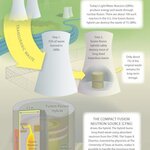Energy

I interrupt my battery history series for this important news:
In case you hadn't heard, the next big thing in batteries is fast charge and discharge times. One of the main hangups with electric cars is that they take too long to charge. Most people don't want to spend several hours "fueling" their car with electrons after a century of a five minute fill up. Recent advances in battery materials such as lithium titanate (Altair Nanosystems) and lithium iron phosphate (A123 Systems) have allowed the development of batteries that can charge in a matter of minutes instead of hours. This is all…

The creation of long platinum nanowires at the University of Rochester could soon lead to the development of commercially viable fuel cells.
Described in a paper published today in the journal Nano Letters, the new wires should provide significant increases in both the longevity and efficiency of fuel cells, which have until now been used largely for such exotic purposes as powering spacecraft. Nanowire enhanced fuel cells could power many types of vehicles, helping reduce the use of petroleum fuels for transportation, according to lead author James C. M. Li, professor of mechanical…

For millions of years, green plants have employed photosynthesis to capture energy from sunlight and convert it into electrochemical energy. A goal of scientists has been to develop an artificial version of photosynthesis that can be used to produce liquid fuels from carbon dioxide and water. Researchers with Lawrence Berkeley National Laboratoryhave now taken a critical step towards this goal with the discovery that nano-sized crystals of cobalt oxide can effectively carry out the critical photosynthetic reaction of splitting water molecules.
Artificial photosynthesis for the production of…

Dual catalysts may be the key to efficiently turning carbon dioxide and water vapor into methane and other hydrocarbons using titania nanotubes and solar power, according to Penn State researchers.
Burning fossil fuels like oil, gas and coal release large amounts of carbon dioxide, a greenhouse gas, into the atmosphere. Rather than contribute to global climate change, producers could convert carbon dioxide to a wide variety of hydrocarbons, but this makes sense to do only when using solar energy.
"Recycling of carbon dioxide via conversion into a high energy-content fuel, suitable for use in…

Geothermal energy is increasingly contributing to the power supply where it is affordable and efficient. Iceland is world-leader in expanding development of geothermal utilization: in recent years the annual power supply there doubled to more than 500 MW in the supply of electricity. Even in Germany, over 100 MW of heat are currently being provided through geothermal energy.
In the region of Travale, in the pioneering country Italy, a team of european scientists have localizied geothermal reservoirs, holding a potential comparable to the effectiveness of 1,000 wind power plants…

So, it has been quite some time since I've posted a blog. Unfortunately, I am trying to get this pesky degree and do some research on the side. I would like to continue my history of the battery with the development of the first rechargeable battery. Our sojourn takes us now to France; however, the year is now 1859.
Gaston Planté was a French physicist who conducted a variety of experiments in the field of electricity. He is best known for the invention of the first rechargeable electrochemical cell, the lead-acid battery. A lead acid battery consists of a negative lead terminal ("spongy"…

Should the government or private industry shoulder the initiative for meaningful strides in alternative energy breakthroughs? The level of disruption necessary cannot be achieved on any practial time horizon by private industry without some enormous stroke of luck. Obama's references to JFK, an energy moonshot and government initiatives in this area is the best hope, but the logistics of propelling this economically and pragmatically are unclear. An encouraging answer is some combination of private and public effort such as the DOE's initiative to partner national…

With its light body made of Kevlar, sleek aerodynamic design and three Olympic-racing wheelchair tires, it looks like something that escaped from the Batcave but it’s actually a school project by a team of six Dalhousie University senior mechanical engineering students.
The ultimate in fuel efficiency, the “Maritime Mileage Machine” will be entered in the 2009 Shell Eco-marathon Americas taking place on April 15 to 18 at the Auto Club Speedway in Fontana, California. The event challenges high school and post-secondary students across Canada, the U.S., Mexico and South America to design and…

A team of MIT undergraduate students has invented a shock absorber that harnesses energy from small bumps in the road, generating electricity while it smoothes the ride more effectively than conventional shocks. The students hope to initially find customers among companies that operate large fleets of heavy vehicles. They have already drawn interest from the U.S. military and several truck manufacturers.
Senior Shakeel Avadhany and his teammates say they can produce up to a 10 percent improvement in overall vehicle fuel efficiency by using the regenerative shock absorbers. The company that…

It's been nearly thirty years since the last application for construction of a nuclear power plant was filed in the United States. Despite the age of the reactors already operating, however, the amount of our power generated using nuclear sources is second only to coal. The energy generated by nuclear plants is also increasing steadily, as delays in refueling shorten and reactors operate for longer periods of time. However, there are still numerous environmental concerns regarding the waste products generated by American nuclear reactors - by 2010, the total amount of dangerous waste will…